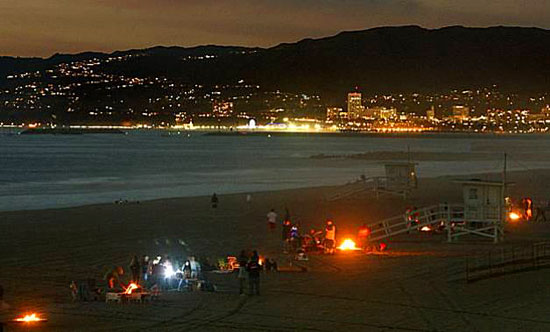Lowering the heat on bonfire dispute
June 5, 2013

A shift in direction by air quality officials could keep fires burning on Dockweiler State Beach. Photo/L.A. Times
A hotly contested proposal to ban wood burning in Southern California’s iconic beach fire rings appears to be going up in smoke.
An official with the South Coast Air Quality Management District said in an interview on Wednesday that “an alternative proposal” had been developed that would continue to allow bonfires on the region’s beaches so long as certain measures were undertaken by June, 2014, to minimize the known harmful effects of burning wood.
“From our standpoint, we have better and more information than we had two months ago,” said AQMD project manager Tracy Goss. “A one-size-fits-all doesn’t necessarily apply in this case.”
And that’s good news for the popular pits at Dockweiler State Beach, which, under the earlier proposal, would have fallen victim to a dispute flaring 50 miles south, where Newport Beach officials are determined to remove 60 fire rings. Some residents there have complained of respiratory problems and smoke-drenched homes. At Dockweiler, the neighbors include LAX, a sewage treatment plant and an oil refinery, and they’re not complaining.
Restricting fires at Dockweiler for health reasons “doesn’t make a whole lot of sense,” Goss acknowledged, noting that the latest proposal would take a more nuanced beach-by-beach approach based on such things as topography, wind and proximity to homes. Goss declined to provide specifics until the plan’s public release, scheduled for Thursday. Already, the agency has two “public consultation meetings” set for next week on the new proposed amendments to Rule 444, which regulates “open burning.”
Of the national attention the AQMD’s earlier proposal attracted, Goss, a 25-year veteran of the agency, said: “When they make a political cartoon of your issue, that doesn’t happen very often.”
Kerry Silverstrom, chief deputy director of L.A. County’s Department of Beaches and Harbors, welcomed the news that Dockweiler’s fire pits will likely be spared. “We’re delighted,” she said. But she questioned why they were ever at risk. “On the scale of what’s bad for us,” she said, “fire rings at Dockweiler wouldn’t be the first thing I’d be talking about.”
She said the concrete rings have been there since at least the mid-1970s, when the county began running the beach at the foot of Imperial Highway. As much as 43 percent of Dockweiler’s annual parking revenues, or $570,000, comes from fees after 4 p.m., Silverstrom said—clear evidence of the popularity of the rings. “They provide a low cost recreational opportunity for a diverse population,” she said. “We see it as an access issue.”
So did the staff of the California Coastal Commission when, in February, it recommended denying Newport Beach a permit to remove fire pits that the mayor and city council contended were jeopardizing residents’ health. (Critics accused homeowners of simply trying to discourage undesirable outsiders from flocking to their affluent neighborhood.)
The commission staff stated that the removal of the rings would “deny the public access to this popular form of lower cost public recreation.” It also said the city had failed to demonstrate that the rings were “directly responsible” for health problems.
It was around this time that the AQMD entered the fray at the urging of board chairman William Burke, who also sat on the Coastal Commission—a job from which he’d resign as questions arose in Sacramento over a potential conflict between his positions on two agencies at odds with each other.
More specifically, Burke’s departure came after he said during an AQMD meeting in February that a nighttime aerial picture of the Newport fire rings reminded him of “carpet bombing” in Viet Nam, where he’d served in the armed forces. “This is Viet Nam revisited,” Burke said, but then quickly added: “Now it’s not really that bad because Viet Nam was horrible.”
As the AQMD continued to push for a regional ban, other cities pushed back, most notably Huntington Beach, which said its fire rings were a source of pride and commerce; they help “surf city” reap $1 million annually in parking revenues.
On Tuesday, the city’s community relations officer, Laurie Frymire, appeared before members of the Los Angeles County Board of Supervisors. “Our fire rings have been enjoyed for more than 60 years by folks from all over,” Frymire said, as she thanked supervisors for passing a motion by Don Knabe, whose 4th District includes Dockweiler Beach. The motion called on the board to oppose any action by the AQMD to ban fire rings region-wide and to leave such decisions to local jurisdictions. The Orange County Board of Supervisors, among other local government bodies, had earlier passed similar measures.
Now, given the shift in position by the AQMD staff, it looks increasingly likely that, at least in L.A. County, fire pits will no longer be a burning issue.
Posted 6/5/13












 405 bridge work causes a stink
405 bridge work causes a stink
